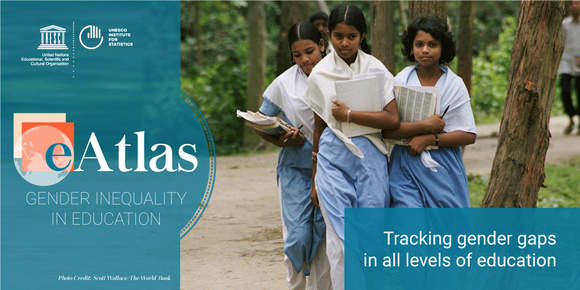
UNESCO launched in 2012 the report “Gender Parity Index (GPI)”. Updated information for 2016 is already available in the “eAtlas of Gender Equality and Education”, which shows data for all levels of education disaggregated by sex across time, the information presented is collected by the UNESCO Institute for Statistics (UIS) with partnership of the OECD and Eurostat.
The following maps (maps 1 and 2) illustrate the percentage of girls of official primary school age not enrolled in primary or secondary school by country, some changes are observed when comparing 2000 and 2016, note that most of the countries with levels of 30% or more are found in the region of Sub-Saharan Africa.

The countries with more out of school girls in primary education are: Nigeria with 5 million girls out of school, Pakistan 3.3 million, and India 2.5 million girls. For secondary education: Pakistan has the largest number of girls out of school (2.9 million), India (2.7 million), and Ethiopia (1.9 million). Worldwide, 10% of girls in ages 6 to 11 are excluded from education (as compared to 8% of the boys), regarding secondary education, in Western Asia, 20% of adolescent girls cannot access to it (boys represent a 13%).
School life expectancy (SLE) indicates the average number of years that boys and girls expect to receive of education. Since 1990 Eastern Asia made the greatest progress, where a girl starting school could only expect 8 years of education, compared to 14 years they can expect in 2016. During this period of years, gender parity has been achieved by most of the countries as observed in the maps below (maps 3 and 4).

The Gender Parity Index (GPI) allows an analysis of (un)equal participation for girls and boys in education. Most of the countries from South and West Asia, Arab States, and Sub-Saharan Africa regions have not yet achieved it for neither primary nor secondary education. A great part of countries who belong to the regions East Asia and the Pacific and Latin America and the Caribbean have achieved parity for primary education only, while in North America and Western Europe and Central and Eastern Europe have parities achieved for primary and secondary education (with a tendency to beneficiate girls). Countries register general GPI´s between 0.97 and 1.03, lesser values indicate disparity in favor of boys, while a greater value for girls.
The countries with lower GPI values in primary school are: Somalia (.55), Angola (.64) and Afghanistan (.69), where boys have an advantage; while the higher values of GPI are for the countries: Montserrat (1.12), Senegal (1.12) and India (1.11), meaning girls are favored in primary school enrolment.
Portugal, along with Belize, Bolivia, Chile, El Salvador, India, Iran, Senegal, Lebanon, and Swaziland, are the countries who have achieved gender parity in secondary education but have not yet in primary education.
Follows the maps (5 and 6) that show the GPI by country in 2016 for primary and secondary school. Where it is observed that as school levels increase disparity affecting boys, rather than girls, increases.

As noted before, the inverse disparity situation manifests also in the gross enrolment rates (GER), which for adolescent girls in secondary level are higher than for boys in one in three countries (33%), while adolescent boys have an advantage in 29% of the countries.
Comparative analysis indicates that girls are just as likely as boys to repeat a grade in primary school. Nevertheless, boys are more likely than girls to leave school early. The regions where children face more challenges in completing primary school are: sub-Saharan Africa, where 43% of pupils leave school early, Southern Asia for 34% of pupils, and Eastern Asia with 25% of children in such situation.
In most of the countries (with available data) boys and girls have the same chance to transition from primary to secondary education, the GPI for the transition rate is shown in the map 7.

Large differences among regions are seen in what regards to lower secondary education conclusion, for example: in Latin America and the Caribbean, the gross intake ratio to the last grade of lower secondary education indicates that more than three out of four young adolescents (77%) complete a full course in this level, while in sub-Saharan Africa two in five young adolescents (42%) complete it.
Results show that even though progress has been made worldwide along the time, in some regions of the world there are challenges to incorporate young girls in school in order to achieve parity. While in some other regions an inverse situation is observed, where an effort is needed in order to have equal educational outcomes for adolescent boys.
By: Andrea Oceguera Farías
